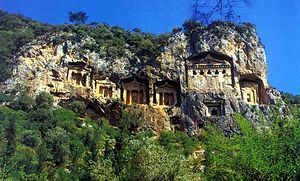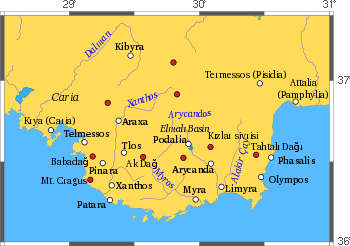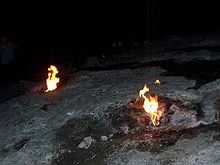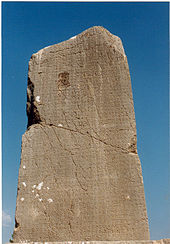- Lycia
-
Lycia (Λυκία) Ancient Region of Anatolia
Lycian rock cut tombs of DalyanLocation Southern Anatolia State existed 15-14th c. BC (as Lukka)
1250–546 BCLanguage Lycian Historical capitals Xanthos Roman province Lycia 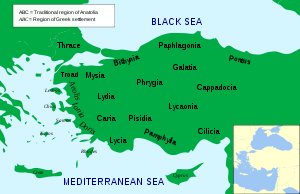
Lycia (
 /ˈlɪʃə/;[1] Lycian: Trm̃mis; Greek: Λυκία) was a region in Anatolia in what are now the provinces of Antalya and Muğla on the southern coast of Turkey. It was a federation of ancient cities in the region and later a province of the Roman Empire. The Lycian League founded in 168 BC was an early federation with democratic principles; these later influenced the United States Constitution.[2]
/ˈlɪʃə/;[1] Lycian: Trm̃mis; Greek: Λυκία) was a region in Anatolia in what are now the provinces of Antalya and Muğla on the southern coast of Turkey. It was a federation of ancient cities in the region and later a province of the Roman Empire. The Lycian League founded in 168 BC was an early federation with democratic principles; these later influenced the United States Constitution.[2]Contents
Geography
The borders of Lycia varied over time but at its center was the Teke peninsula in south-western Turkey. It was bounded by Caria to the west and north west, Pamphylia to the east, and Pisidia to the north east. The region is mountainous and densely forested region with few large valleys. The mountains are the westernmost part of the Taurus mountains in particular the Akdağ and Beydağı mountains whose peaks can exceed 3000 meters. Inland is the Elmalı basin. The major rivers are the Eşen Çay (ancient Xanthos river), Demre Çay (ancient Myros river), Arykandos, and Alakir Çay. The area is known for steep gorges and underground rivers.[3]
Modern
In modern Turkey the region is split between Antalya (on the east) and Muğla (on the west) provinces. The major city is Fethiye built on ancient Telmessos. Well known towns include Kalkan, Kaş, and Demre (ancient Myra). Inland Elmalı is fairly important.
Turkey's first waymarked long-distance footpath, the Lycian Way, follows part of the coast of the region.
Ancient
The principal cities of ancient Lycia were Xanthos, Patara, Myra, Pinara, Tlos and Olympos (each entitled to three votes in the Lycian League) and Phaselis. Cities such as Telmessos and Krya were sometimes listed by Classical authors as Carian and sometimes as Lycian.
Ancient names can sometimes be difficult to match with modern features: the Cragus and Anticragus mountains on the west side of the Xanthos river seem to include modern Babadağ.
Features and sights of interest
Although the 2nd-century AD dialogue, Erōtes, found the cities of Lycia "interesting more for their history than for their monuments, since they have retained none of their former splendor," many relics of the Lycians remain visible today. These relics include the distinctive rock-cut tombs in the sides of cliffs. The British Museum in London has one of the best collections of Lycian artifacts. Letoon, an important center in Hellenic times of worship for the goddess Leto and her twin children, Apollo and Artemis, and nearby Xanthos, ancient capital of Lycia, constitute a UNESCO World Heritage site.[4]
Ancient language
The eponymous inhabitants of Lycia, the Lycians, spoke an Indo-European language, belonging to the Anatolian branch. The closest language to the Lycian language is the Luwian language, which was spoken in Anatolia during the 2nd and the early 1st millennia BC; Lycian may even be one of Luwian's direct descendants.
History
Bronze age
Ancient Egyptian records describe the Lycians as allies of the Hittites. Lycia may have been a member state of the Assuwa league of ca. 1250 BC, appearing as 'Lukka or Luqqa. After the collapse of the Hittite Empire, Lycia emerged as an independent "Neo-Hittite" kingdom. According to Herodotus, Lycia was named after Lycus, the son of Pandion II of Athens. The region was never unified into a single territory in antiquity, but remained a tightly-knit confederation of fiercely independent city-states.
Lycia was frequently mentioned by Homer as an ally of Troy. In Homer's Iliad, the Lycian contingent was said to have been led by two esteemed warriors: Sarpedon (son of Zeus and Laodamia) and Glaucus (son of Hippolochus). Elsewhere in Greek mythology, the Lycian kingdom was said to have been ruled by another Sarpedon, a Cretan exile and brother of the king Minos; Sarpedon's followers were called Termilae, and they founded a dynasty after their conquest of a people called the Milyans. As with the founding of Miletus, this mythical story implies a Cretan connection to the settlement of Asia Minor. Lycia appears elsewhere in Greek myth, such as in the story of Bellerophon, who eventually succeeded to the throne of the Lycian king Iobates (or Amphianax).
Classical period
Lycia came under the control of the Persian Empire in 546 BC when Harpagus of Media, a general in the service of Cyrus conquered Asia Minor. Harpagus's descendants ruled Lycia until 468 BC when Athens wrested control away. Following the ousting of the Persians, as Athens and Sparta fought the Peloponnesian wars, the majority of Lycian cities defaulted from the Delian League, with the exception of Telmessos and Phaselis.
In 429 BC, Athens sent an expedition against Lycia to try to force it to rejoin the league. This failed when Lycia's leader Gergis of Xanthos defeated General Melasander. The Lycians once again fell under Persian domination and by 412 BC, Lycia is documented as fighting on the winning side of Persia. The Persian satraps were re-installed, but (as the coinage of the time attests) they allowed local dynasts the freedom to rule.[5] Persia held Lycia until it was conquered by Alexander III (the Great) of Macedon during 334–333 BC.[6]
Hellenistic period
After the death of Alexander the Great in 324 BC, his generals fought amongst themselves over the succession. Lycia fell into the hands of the general Antigonus by 304 BC. In 301 BC Antigonus was killed by an alliance of the other successors of Alexander, and Lycia became a part of the kingdom of Lysimachus, who ruled until he was killed in battle in 281 BC.[7] By 240 BC Lycia was part of the Ptolemaic Kingdom, centred on Egypt,[8] and remained in their control through 200 BC.[9] It had apparently come under Seleucid control by 190 BC, when the Seleucids' defeat in the Battle of Magnesia resulted in Lycia being awarded to Rhodes in the Peace of Apamea in 188 BC. It was then granted independence by Rome in 168 BC (see Lycian League below) and remained so until becoming a Roman province in 43 AD.[10]
Lycian League
LYCIAN LEAGUE City Votes Xanthos 3 Patara 3 Myra 3 Pinara 3 Tlos 3 Olympos 3 Cybira 2 Boubon 2 Balbira, Lycia 1 Oenoanda 1 Simpolity of Aperlae, Simena,
Isinda, Apollonia, Lycia1 The Lycian League (Itlehi Trm̃mili) first came together around 205 BC and was formally established in 168 BC under democratic principles. It comprised some 23 known city-states as members. Lycia, which had been under Rhodian control since the Peace of Apamea in 188 BC, was granted independence by the Roman Republic at the conclusion of the Third Macedonian War. These city states joined together in a federal-style government that shared political resources against larger nations. A “Lyciarch” was elected by a senate that convened every autumn at a different city, where each member sent one, two or three representatives, depending on the city's size, to the senate, or Bouleuterion, as it was called.
The major cities of the League included Xanthos, Patara, Pinara, Olympos, Myra, and Tlos, with Patara as the capital. Phaselis joined the League at a later time. The league continued to function after Lycia became a Roman province in 46 AD. Lycia ceased being a federation in the 4th century AD, when it was taken over by the Byzantine Empire.
Roman period
Main article: Lycia et PamphyliaIn 43AD, the emperor Claudius annexed it to the Roman Empire as a province and by the time of Vespasian, it was united with Pamphylia as a Roman province.[11] The heir of Augustus, Gaius Caesar, was killed there in 4 AD.
Byzantine era
It subsequently was a part of the Byzantine Empire.
Turkish era
It was incorporated into the Ottoman (Turkish) Empire and eventually became part of Turkey. A substantial Christian community of Greeks lived in Lycia until the 1920s when they were forced to migrate to Greece after the Population exchange between Greece and Turkey following the Greco-Turkish War in the early 20th century.[12] The abandoned Greek villages in the region are a striking reminder of this exodus. Abandoned Greek houses can still be seen at in the towns of Demre, Kalkan, Kas and Kaya which is a Greek ghost town.[12] A small population of Turkish farmers moved into the region when the Lycian Greeks migrated to Greece.[12] The region is now one of the key centres of domestic and foreign tourism in Turkey.
See also
- Lycian script
- Tomb of Amyntas
References
- ^ "Lycia". YourDictionary.com. Love To Know Corp. http://www.yourdictionary.com/Lycia. Retrieved 2010-10-13.
- ^ Bernstein, Richard (September 19, 2005). "A Congress, Buried in Turkey's Sand". The New York Time. Archived from the original on 13 October 2010. http://www.webcitation.org/5tRy6BaOZ.
- ^ Foss, Pedar W.. "Lycia: people and places". Encyclopeida of Roman Provinces. People.usd.edu. http://people.usd.edu/~clehmann/erp/Lycia/lycplace.html#geol. Retrieved 2010-07-07.
- ^ "Xanthos-Letoon". World Heritage – The List. UNESCO. http://whc.unesco.org/en/list/484/. Retrieved 13 October 2010.
- ^ "Lycian Dynasts". Asia Minor Coins. 13 July 2009. http://www.asiaminorcoins.com/gallery/thumbnails.php?album=262. Retrieved 7 July 2010.
- ^ Haywood, John, et al. Historical Atlas of the Classical World: 500 BC – AD 600. Barnes & Noble Books: New York, New York, 2002, Plate 2.09.
- ^ Haywood
- ^ Barraclough, Geoffrey, ed. Collins Atlas of World History. Borders Press: Ann Arbor, Michigan, 2003, p. 77.
- ^ Black, Jeremy, ed. World History Atlas. Dorling Kindersley: London, 2000, p. 179.
- ^ Barraclough
- ^ Şahin, S. and M. Adak, Stadiasmus Patarensis. Itinera Romana Provinciae Lyciae. İstanbul 2007; F. Onur, Two Procuratorian Inscriptions from Perge, Gephyra 5 (2008), 53–66.
- ^ a b c Darke, Diana (1986). Guide to Aegean and Mediterranean Turkey. M. Haag. p. 160. ISBN 0902743341, 9780902743342. "The Lycians were essentially Greeks so they went to Greece, leaving a small population of Turkish farmers to move in behind them. The Greek ghost town of Kaya in the hills behind Fethiye is the most dramatic reminder of this exodus, but derelict Greek houses can also be seen at Kalkan, Kas and Demre."
Sources
Primary sources
- “Poem on the Battle of Kadesh” 305–313, Ramesses II
- “Great Karnak Inscription” 572–592, Merneptah
-
- Breasted, J. H. 1906. Ancient Records of Egypt. Vol. III. Chicago: University of Chicago Press.
- “Plague Prayers of Mursilis” A1–11, b, Mursilis
-
- Pritchard, J. B. 1969. Ancient Near Eastern Texts. Princeton: Princeton University Press.
Secondary sources
- R. D. Barnett (1975). "The Sea Peoples". In J. B. Bury, S. A. Cook, F. E. Adcock. The Cambridge Ancient History. II, part 2. Cambridge: Cambridge University Press. pp. 362–366. – Refers to many different sea peoples and their contact with Egypt and Anatolia. Also tells about the Philistines during the reign of Ramesses III.
- T. Bryce (1993). "Lukka Revisited". Journal of Near Eastern Studies 51 (2): 121–130. doi:10.1086/373535. – Discusses Lukka's relations to other regions (like Miletus) and where they inhabited.
- T. Bryce and J. Zahle (1986). The Lycians. 1. Copenhagen: Museum Tusculanum Press. – Covers the Lycians and where they lived, their history, language, culture, cults, and their language.
- R. Drews (1995). The End of the Bronze Age: Changes in Warfare and the Catastrophe CA. 1200 B.C.. Princeton: Princeton University Press. – A description of the Egyptian evidence on the Sea Peoples.
External links
- Lycian way in Turkey,infermation
- Lycian Turkey
- Christian Lycia
- Etching of a Lycian tomb from A. D. F. Hamlin's A History of Ornament (New York: The Century Company, 1916)
- Lycian League: Prototype of America's Democracy? from Saudi Aramco World magazine, September/October 2007
- Lycian Influence to the Indian Cave Temples
- Encyclopedia of the Roman Provinces: Lycia. Pedar W. Foss. Good starting point for sources.
- QTVR fullscreen panoramas of the rock-cut tombs of the ancient Lycian necropolis at Myra
Historical regions of Anatolia History of Anatolia 
Provinces of the Roman Empire at its greatest extent (117 AD) Achaea · Aegyptus · Africa · Alpes Cottiae · Alpes Maritimae · Alpes Poeninae · Arabia Petraea · Armenia · Asia · Assyria · Bithynia et Pontus · Britannia · Cappadocia · Cilicia · Corsica et Sardinia · Creta et Cyrenaica · Cyprus · Dacia · Dalmatia · Epirus · Galatia · Gallia Aquitania · Gallia Belgica · Gallia Lugdunensis · Gallia Narbonensis · Germania Inferior · Germania Superior · Hispania Baetica · Hispania Tarraconensis · Italia · Iudaea · Lusitania · Lycia et Pamphylia · Macedonia · Mauretania Caesariensis · Mauretania Tingitana · Mesopotamia · Moesia Inferior · Moesia Superior · Noricum · Pannonia Inferior · Pannonia Superior · Raetia · Sicilia · Syria · Thracia

Late Roman Provinces (4th–7th centuries) History Provincial administration reformed and dioceses established by Diocletian, c. 293. Permanent praetorian prefectures established after the death of Constantine I. Empire permanently partitioned after 395. Exarchates of Ravenna and Africa established after 584. After massive territorial losses in the 7th century, the remaining provinces were superseded by the theme system in c. 640–660, although in Asia Minor and parts of Greece they survived under the latter until the early 9th century.Praetorian
Prefecture of GaulDiocese of Gaul: Alpes Poeninae et Graiae • Belgica I • Belgica II • Germania I • Germania II • Lugdunensis I • Lugdunensis II • Lugdunensis III • Lugdunensis IV • Maxima Sequanorum
Diocese of Vienne (later Septem Provinciae): Alpes Maritimae • Aquitanica I • Aquitanica II • Narbonensis I • Narbonensis II • Novempopulania • Viennensis
Diocese of Spain: Baetica • Balearica • Carthaginensis • Gallaecia • Lusitania • Mauretania Tingitana • Tarraconensis
Diocese of Britain: Britannia I • Britannia II • Flavia Caesariensis • Maxima Caesariensis • Valentia (369)Praetorian
Prefecture of ItalyDiocese of Suburbicarian Italy: Apulia et Calabria • Bruttia et Lucania • Campania • Corsica • Picenum Suburbicarium • Samnium • Sardinia • Sicilia • Tuscia et Umbria • Valeria
Diocese of Annonarian Italy: Alpes Cottiae • Flaminia et Picenum Annonarium • Liguria et Aemilia • Raetia I • Raetia II • Venetia et Istria
Diocese of Africa†: Africa proconsularis (Zeugitana) • Byzacena • Mauretania Caesariensis • Mauretania Sitifensis • Numidia Cirtensis • Numidia Militiana • Tripolitania
Diocese of Pannonia (later of Illyricum): Dalmatia • Noricum mediterraneum • Noricum ripense • Pannonia I • Pannonia II • Savia • Valeria ripensisPraetorian
Prefecture of IllyricumPraetorian
Prefecture of the EastDiocese of Thrace: Europa • Haemimontus • Moesia II§ • Rhodope • Scythia§ • Thracia
Diocese of Asia*: Asia • Caria§ • Hellespontus • Insulae§ • Lycaonia (370) • Lycia • Lydia • Pamphylia • Pisidia • Phrygia Pacatiana • Phrygia Salutaria
Diocese of Pontus*: Armenia I* • Armenia II* • Armenia Maior* • Armenian Satrapies* • Armenia III (536) • Armenia IV (536) • Bithynia • Cappadocia I* • Cappadocia II* • Galatia I* • Galatia II Salutaris* • Helenopontus* • Honorias* • Paphlagonia* • Pontus Polemoniacus*
Diocese of the East: Arabia • Cilicia I • Cilicia II • Cyprus§ • Euphratensis • Isauria • Mesopotamia • Osroene • Palaestina I • Palaestina II • Palaestina III Salutaris • Phoenice • Phoenice Libanensis • Syria I • Syria II Salutaris • Theodorias (528)
Diocese of Egypt: Aegyptus I • Aegyptus II • Arcadia • Augustamnica I • Augustamnica II • Libya Superior • Libya Inferior • Thebais Superior • Thebais InferiorOther territories - affected (boundaries modified/abolished/renamed) by Justinian I's administrative reorganization in 534–536 † re-established after reconquest by the Eastern Empire in 534, as the separate prefecture of Africa § joined together into the Quaestura exercitus in 536
Aegean Black Sea Central Anatolia East Anatolia Ishak Pasha Palace · The Tombstones of Ahlat the Urartian and Ottoman citadelMarmara Mediterranean Alahan Monastery · Alanya · Ancient Cities of Lycian Civilization · Archaeological Site of Perge · Archaeological Site of Sagalassos · Güllük Dagi-Termessos National Park · Hatay, St. Pierre Church · Karain Cave · Kekova · St. Nicholas Church · St.Paul Church, St.Paul's Well and surrounding historic quarters (Tarsus)Southeastern Anatolia Harran and Sanliurfa · Mardin Cultural Landscape · The Archaeological Site of Göbeklitepe · The Citadel and the Walls of DiyarbakirAll over Turkey Seljuk Caravanserais on the route from Denizli to Dogubeyazit
Categories:- World Heritage Sites in Turkey
- Lycia
- Ancient Roman provinces
- Antalya Province
- Historical regions of Anatolia
- Muğla Province
- Seleucid Empire
- Rock-cut tombs
Wikimedia Foundation. 2010.

